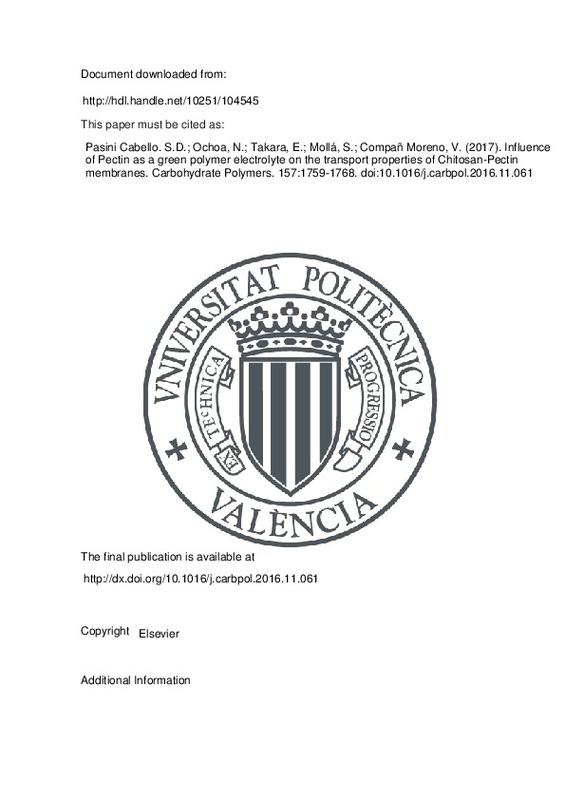JavaScript is disabled for your browser. Some features of this site may not work without it.
Buscar en RiuNet
Listar
Mi cuenta
Estadísticas
Ayuda RiuNet
Admin. UPV
Influence of Pectin as a green polymer electrolyte on the transport properties of Chitosan-Pectin membranes
Mostrar el registro sencillo del ítem
Ficheros en el ítem
| dc.contributor.author | Pasini Cabello. S.D.
|
es_ES |
| dc.contributor.author | Ochoa, N.A.
|
es_ES |
| dc.contributor.author | Takara, E.A.
|
es_ES |
| dc.contributor.author | Mollá, S.
|
es_ES |
| dc.contributor.author | Compañ Moreno, Vicente
|
es_ES |
| dc.date.accessioned | 2018-06-23T04:22:04Z | |
| dc.date.available | 2018-06-23T04:22:04Z | |
| dc.date.issued | 2017 | es_ES |
| dc.identifier.issn | 0144-8617 | es_ES |
| dc.identifier.uri | http://hdl.handle.net/10251/104545 | |
| dc.description.abstract | [EN] Novel blend membranes have been prepared from Chitosan (CH), Pectin (PEC) and their mixtures. The obtained samples were cross-linked and sulfonated before characterization. The results show that CH/PEC membranes display structural changes on the chemical and physical properties as a function of composition. DSC analysis reveals an endothermic peak due to the scission of the ionic pairs between carboxylic groups and ammonium groups, which produces a strong change on physical properties such as methanol permeability and proton conductivity. The methanol permeability decreases with the amount of Pectin from (4.24 +/- 0.04) x 10(-6) cm(2)/s for pure Chitosan membrane to (1.51 +/- 0.03) x 10(-6) cm(2)/s for blend CH/PEC membranes when the amount of Pectin is 50% (v/v). The proton conductivities of the blend membranes follow a similar behavior. For a pure CH membrane the conductivity is 2.44 x 10(-3) S/cm, decreasing with pectin content until the composition 50/50 (v/v), in which the conductivity drops almost one order of magnitude. (C) 2016 Elsevier Ltd. All rights reserved. | es_ES |
| dc.description.sponsorship | This research has been supported by the ENE/2015-69203-R project, granted by the Ministerio de Economia y Competitividad, Spain, and grants from ANPCyT, Universidad Nacional de San Luis, CONICET, Argentina. Sergio David Pasini Cabello thanks Erasmus Mundus Program for a EUROTANGO 2 fellowship at the Universidad Politecnica de Valencia (UPV). | en_EN |
| dc.language | Inglés | es_ES |
| dc.publisher | Elsevier | es_ES |
| dc.relation.ispartof | Carbohydrate Polymers | es_ES |
| dc.rights | Reserva de todos los derechos | es_ES |
| dc.subject | Biopolymeric membranes | es_ES |
| dc.subject | Polymer electrolyte membranes (PEM) | es_ES |
| dc.subject | Methanol permeability | es_ES |
| dc.subject | Proton conductivity | es_ES |
| dc.subject | Differential scanning calorimetry (DSC) | es_ES |
| dc.subject | Electrochemical techniques | es_ES |
| dc.subject.classification | FISICA APLICADA | es_ES |
| dc.subject.classification | MAQUINAS Y MOTORES TERMICOS | es_ES |
| dc.title | Influence of Pectin as a green polymer electrolyte on the transport properties of Chitosan-Pectin membranes | es_ES |
| dc.type | Artículo | es_ES |
| dc.identifier.doi | 10.1016/j.carbpol.2016.11.061 | es_ES |
| dc.relation.projectID | info:eu-repo/grantAgreement/MINECO//ENE2015-69203-R/ES/DESARROLLO Y EVALUACION DE NUEVAS MEMBRANAS POLIMERICAS REFORZADAS CON NANOFIBRAS PARA SU APLICACION EN PILAS DE COMBUSTIBLE CON ELEVADA ESTABILIDAD TERMICA/ | es_ES |
| dc.rights.accessRights | Abierto | es_ES |
| dc.contributor.affiliation | Universitat Politècnica de València. Departamento de Termodinámica Aplicada - Departament de Termodinàmica Aplicada | es_ES |
| dc.description.bibliographicCitation | Pasini Cabello. S.D.; Ochoa, N.; Takara, E.; Mollá, S.; Compañ Moreno, V. (2017). Influence of Pectin as a green polymer electrolyte on the transport properties of Chitosan-Pectin membranes. Carbohydrate Polymers. 157:1759-1768. https://doi.org/10.1016/j.carbpol.2016.11.061 | es_ES |
| dc.description.accrualMethod | S | es_ES |
| dc.relation.publisherversion | http://dx.doi.org/10.1016/j.carbpol.2016.11.061 | es_ES |
| dc.description.upvformatpinicio | 1759 | es_ES |
| dc.description.upvformatpfin | 1768 | es_ES |
| dc.type.version | info:eu-repo/semantics/publishedVersion | es_ES |
| dc.description.volume | 157 | es_ES |
| dc.relation.pasarela | S\350961 | es_ES |
| dc.contributor.funder | Ministerio de Economía, Industria y Competitividad | es_ES |







![[Cerrado]](/themes/UPV/images/candado.png)

